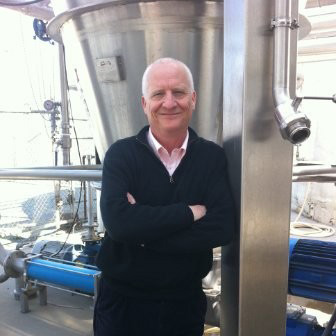
Meet Rick Jones, a native of Flint, MI, a place where viticulture was never even a passing thought. His journey into the world of winemaking started with a chance encounter that changed his life’s course. Rick’s father, a banker, attended a conference and crossed paths with someone from UC Davis Viticulture, sparking the idea that winemaking could be a college pursuit. Little did Rick know that this chance revelation would plant the seed of a future career.
While studying music and art at Antioch College, Rick’s exposure to wine culture grew during a captivating European tour with the college choir. Guided by a professor with a profound passion for food and wine, Rick’s path took an unexpected turn, leading him to UC Davis, where he pursued and earned his BS and Masters degree in Winemaking. After a decade dedicated to honing his winemaking skills, an old friend named Clark Smith approached Rick with a groundbreaking wine processing idea involving specialized filtration.
Historically, wine filtration wasn’t a new concept, as it had been employed in Europe since the 19th century to rid wine of bacteria and solids. However, the idea of using reverse osmosis (R.O) to filter wine at a molecular level, which had been primarily utilized in the late 80s for dealcoholizing wine, was revolutionary. R.O. had initially been invented to desalinate salty water.
Clark and Rick, long-time friends since their Davis days, discussed the concept while sitting around a kitchen table. Clark believed they could use the technology, if coupled with ion exchange, to remove acetic acid from bulk wine, Though intriguing, they questioned whether winemakers really needed this process. Over their combined 20 years of experience in the wine industry, encountering batches of wine requiring such treatment had been rare. High volatile acidity (VA), while undesirable, was not a widespread issue. Even though Clark and Rick had each made about 20 million gallons of wine in the last 10 years they could only think of one 10,000-gallon batch that might require treatment.
Opportunity Knocks
As fate would have it, Clark worked at a winery that owned equipment specifically designed for dealcoholizing wine, which was currently sitting idle and collecting dust. They struck a deal with the winery, agreeing to rent the equipment for a mere $100 per day. Additionally, the winery generously provided a flatbed to transport the equipment.
During the fall of 1992 and winter of 1993, the duo found themselves inundated with requests for their filtration services. Many winemakers were grappling with wines exhibiting very high VA. Rick has a theory explaining this sudden demand. Influential wine critic Robert Parker had begun favorably rating wines that were harvested later with higher sugar levels (Brix). To achieve these higher ratings, winemakers adjusted their processes and picked grapes at higher Brix levels, inadvertently causing the high VA issue. Grapes with higher sugar levels can act as fermentation inhibitors, leading to sluggish fermentation and secondary infections from the vineyard.
Seizing the Moment
Rick and Clark faced a capacity issue with only one operational machine, restricting them to serve one customer at a time. But a stroke of luck turned their situation around. A large winery with a 60,000-gallon high-end estate cab that wouldn’t ferment came to their rescue. The winery requested their services, but with a backlog of other customers, they ended up waitlisted.
To bolster their capacity and solidify their business venture, the generous winery offered financial assistance to purchase another piece of equipment, pushing them to the top of the list. With the expanded capacity, Vinovation was now able to service multiple customers simultaneously.
A Timeline of Vinovation/Winesecrets History
- 1960s: Wine filtration widely adopted to remove yeast and bacteria.
- 1980: Wine filtration widely adopted using asbestos pads; also employed in making non-alcoholic wine.
- 1980: Vinovation co-founders meet while both are enrolled in UC Davis for BS & Masters in Winemaking.
- 1980-1990: founders gain winemaking experience, working with some of the largest wineries in the industry.
- 1990: Vinovation Founded.
- 1991-1992: Early stage idea of using RO permeate passing through ion exchange to remove acetic acid is conceived.
- 1992: Renting filtration equipment on a flatbed at $100/day.
- Winter 1993: Demand for their filtration services surges due to winemakers facing high VA issues.
- 1994/1995: Realized RO permeate could be used to make distilled alcohol or lower alcohol, assisting with taxes and adjusting alcohol levels in wine.
- 1997 Vinovation VA Removal process patent approved.
- 2003 Winesecrets was established
- 2008 Vinnovation became part of Winesecrets
Conclusion
The story of Vinovation exemplifies how serendipitous encounters and creative problemsolving can transform challenges into remarkable opportunities. Rick Jones and Clark Smith’s journey from a kitchen table discussion to revolutionizing wine filtration demonstrates the power of innovation and the ability to adapt to the changing needs of the wine industry. Their tenacity and passion for winemaking have carved a unique path for Vinovation, ensuring Winsecerts’ prominent place in the ever-evolving world of wine processing and production.
This groundbreaking approach to the targeted removal of undesirable molecules from wine is still very important to wine production today. It’s uses are many, but in all they help winemakers retain stylistic integrity when climate and environmental factors create challenges. Want to learn more? Call us at 888-656-5553.

